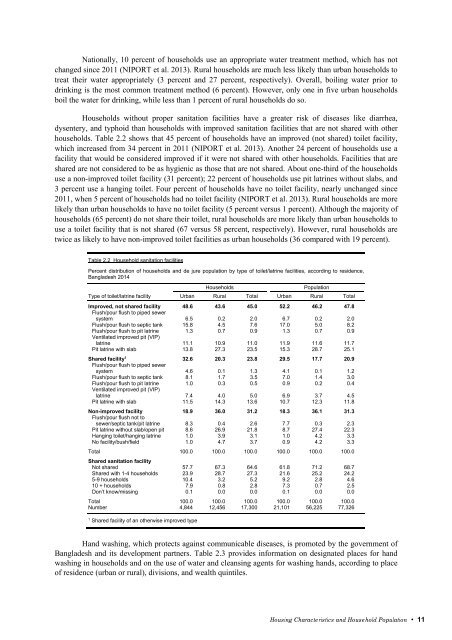Bangladesh 2014
8ln3LMTjp
8ln3LMTjp
Create successful ePaper yourself
Turn your PDF publications into a flip-book with our unique Google optimized e-Paper software.
Nationally, 10 percent of households use an appropriate water treatment method, which has not<br />
changed since 2011 (NIPORT et al. 2013). Rural households are much less likely than urban households to<br />
treat their water appropriately (3 percent and 27 percent, respectively). Overall, boiling water prior to<br />
drinking is the most common treatment method (6 percent). However, only one in five urban households<br />
boil the water for drinking, while less than 1 percent of rural households do so.<br />
Households without proper sanitation facilities have a greater risk of diseases like diarrhea,<br />
dysentery, and typhoid than households with improved sanitation facilities that are not shared with other<br />
households. Table 2.2 shows that 45 percent of households have an improved (not shared) toilet facility,<br />
which increased from 34 percent in 2011 (NIPORT et al. 2013). Another 24 percent of households use a<br />
facility that would be considered improved if it were not shared with other households. Facilities that are<br />
shared are not considered to be as hygienic as those that are not shared. About one-third of the households<br />
use a non-improved toilet facility (31 percent); 22 percent of households use pit latrines without slabs, and<br />
3 percent use a hanging toilet. Four percent of households have no toilet facility, nearly unchanged since<br />
2011, when 5 percent of households had no toilet facility (NIPORT et al. 2013). Rural households are more<br />
likely than urban households to have no toilet facility (5 percent versus 1 percent). Although the majority of<br />
households (65 percent) do not share their toilet, rural households are more likely than urban households to<br />
use a toilet facility that is not shared (67 versus 58 percent, respectively). However, rural households are<br />
twice as likely to have non-improved toilet facilities as urban households (36 compared with 19 percent).<br />
Table 2.2 Household sanitation facilities<br />
Percent distribution of households and de jure population by type of toilet/latrine facilities, according to residence,<br />
<strong>Bangladesh</strong> <strong>2014</strong><br />
Households<br />
Population<br />
Type of toilet/latrine facility Urban Rural Total Urban Rural Total<br />
Improved, not shared facility 48.6 43.6 45.0 52.2 46.2 47.8<br />
Flush/pour flush to piped sewer<br />
system 6.5 0.2 2.0 6.7 0.2 2.0<br />
Flush/pour flush to septic tank 15.8 4.5 7.6 17.0 5.0 8.2<br />
Flush/pour flush to pit latrine 1.3 0.7 0.9 1.3 0.7 0.9<br />
Ventilated improved pit (VIP)<br />
latrine 11.1 10.9 11.0 11.9 11.6 11.7<br />
Pit latrine with slab 13.8 27.3 23.5 15.3 28.7 25.1<br />
Shared facility 1 32.6 20.3 23.8 29.5 17.7 20.9<br />
Flush/pour flush to piped sewer<br />
system 4.6 0.1 1.3 4.1 0.1 1.2<br />
Flush/pour flush to septic tank 8.1 1.7 3.5 7.0 1.4 3.0<br />
Flush/pour flush to pit latrine 1.0 0.3 0.5 0.9 0.2 0.4<br />
Ventilated improved pit (VIP)<br />
latrine 7.4 4.0 5.0 6.9 3.7 4.5<br />
Pit latrine with slab 11.5 14.3 13.6 10.7 12.3 11.8<br />
Non-improved facility 18.9 36.0 31.2 18.3 36.1 31.3<br />
Flush/pour flush not to<br />
sewer/septic tank/pit latrine 8.3 0.4 2.6 7.7 0.3 2.3<br />
Pit latrine without slab/open pit 8.6 26.9 21.8 8.7 27.4 22.3<br />
Hanging toilet/hanging latrine 1.0 3.9 3.1 1.0 4.2 3.3<br />
No facility/bush/field 1.0 4.7 3.7 0.9 4.2 3.3<br />
Total 100.0 100.0 100.0 100.0 100.0 100.0<br />
Shared sanitation facility<br />
Not shared 57.7 67.3 64.6 61.8 71.2 68.7<br />
Shared with 1-4 households 23.9 28.7 27.3 21.6 25.2 24.2<br />
5-9 households 10.4 3.2 5.2 9.2 2.8 4.6<br />
10 + households 7.9 0.8 2.8 7.3 0.7 2.5<br />
Don’t know/missing 0.1 0.0 0.0 0.1 0.0 0.0<br />
Total 100.0 100.0 100.0 100.0 100.0 100.0<br />
Number 4,844 12,456 17,300 21,101 56,225 77,326<br />
1<br />
Shared facility of an otherwise improved type<br />
Hand washing, which protects against communicable diseases, is promoted by the government of<br />
<strong>Bangladesh</strong> and its development partners. Table 2.3 provides information on designated places for hand<br />
washing in households and on the use of water and cleansing agents for washing hands, according to place<br />
of residence (urban or rural), divisions, and wealth quintiles.<br />
Housing Characteristics and Household Population • 11


